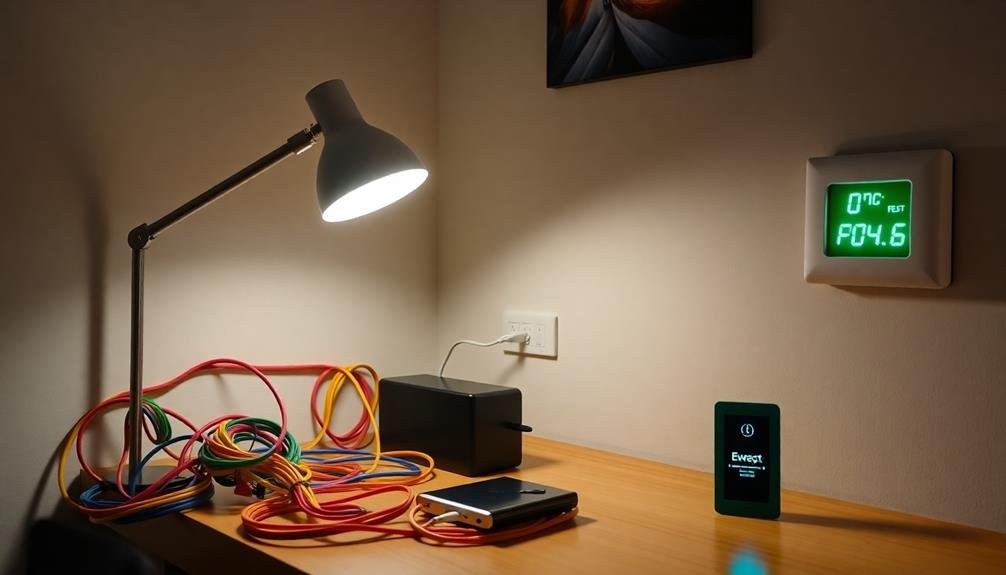The most efficient home hydro turbine depends on your specific site conditions. For high-head, low-flow situations, Pelton wheels excel with their high-efficiency water utilization. Francis turbines offer versatility for moderate to high head heights, achieving up to 90% efficiency under ideal conditions. If you have a low-head site, consider Crossflow or Kaplan turbines. Crossflow turbines handle a wide range of flows and are ideal for residential setups, with efficiencies between 65% and 85%. To maximize efficiency, you'll need to match the turbine type to your site's head and flow rate. Understanding these factors will help you make the best choice for your home hydro system.
Types of Home Hydro Turbines

Diversity in home hydro turbine options empowers homeowners to harness water's energy efficiently.
You'll find several types of turbines suitable for residential use, each designed for specific water flow and head conditions.
Impulse turbines, like the Pelton wheel, are ideal for high-head, low-flow situations. They're efficient and work well with small streams or steep drops.
Turgo turbines, similar to Pelton wheels, can handle higher flow rates and are less sensitive to debris.
For low-head, high-flow scenarios, reaction turbines are your best bet.
Francis turbines are versatile and can operate in various conditions, making them popular for home use.
Kaplan turbines, with their adjustable blades, excel in very low-head situations and can maintain efficiency as water levels fluctuate.
Crossflow turbines bridge the gap between high and low-head applications. They're simple, durable, and can handle a wide range of flows.
For ultra-low head situations, you might consider a waterwheel. While less efficient than modern turbines, they're easy to build and maintain.
When choosing a turbine, consider your site's specific characteristics, including head, flow rate, and seasonal variations.
The right turbine will maximize your system's efficiency and power output.
Factors Affecting Turbine Efficiency
Several key factors influence the efficiency of your home hydro turbine system. The most important is the available head, which is the vertical distance water falls before reaching the turbine. Higher heads generally result in greater efficiency.
Water flow rate also plays a significant role; more water passing through the turbine means more power generation. However, you'll need to balance flow with head for ideal performance.
Turbine design is another critical factor. The type of turbine you choose should match your site's specific conditions. Pelton wheels work best for high head, low flow situations, while cross-flow turbines suit lower head, higher flow scenarios. The quality of components, such as bearings and generators, can greatly impact overall efficiency.
Proper installation and maintenance are essential. Make sure your intake system minimizes debris and air bubbles, as these can reduce efficiency and damage your turbine.
Regular cleaning and lubrication of moving parts will keep your system running smoothly. Additionally, consider the efficiency of your power transmission system, including wiring and inverters, to minimize losses between generation and use.
Pelton Wheel Turbine Performance

You'll find Pelton wheel turbines excel in high-efficiency water utilization, making them an excellent choice for home hydro setups.
They're particularly well-suited for variable flows, adapting seamlessly to changing water conditions in your system.
Their compact and durable design guarantees long-lasting performance while minimizing maintenance needs.
High-Efficiency Water Utilization
How does the Pelton wheel turbine maximize water utilization in home hydro systems?
It's designed to extract maximum energy from high-head, low-flow water sources, making it ideal for residential applications. The turbine's unique bucket-shaped blades efficiently capture the water's kinetic energy, converting it into rotational motion with minimal waste.
To achieve high-efficiency water utilization, the Pelton wheel employs several key features:
- Precise jet alignment: The water jet is carefully aimed at the bucket's center, ensuring optimal energy transfer.
- Split buckets: The divided design allows for smooth water deflection, reducing turbulence and energy loss.
- Adjustable nozzles: You can fine-tune the water flow to match varying conditions, maintaining efficiency across different flow rates.
- Multiple jets: Some Pelton wheels use multiple nozzles to increase power output without sacrificing efficiency.
Ideal for Variable Flows
The Pelton wheel turbine's efficiency extends beyond its water utilization to its performance under variable flow conditions. You'll find this turbine particularly suited for situations where water flow can fluctuate greatly.
Unlike other turbine types, the Pelton wheel maintains high efficiency across a wide range of flows, making it ideal for home hydro systems that experience seasonal changes or inconsistent water supply.
When your stream's flow decreases, you can easily adjust the Pelton wheel by reducing the number of active nozzles. This allows you to maintain peak jet velocity and bucket speed ratio, ensuring maximum efficiency even with reduced water input.
Conversely, during periods of higher flow, you can increase the number of active nozzles to harness more power without sacrificing efficiency.
The Pelton wheel's ability to handle variable flows also means you won't need complex flow regulation systems. This simplifies your setup, reduces maintenance needs, and lowers overall costs.
Whether you're dealing with a small creek that varies seasonally or a more consistent water source, the Pelton wheel turbine adapts seamlessly, providing reliable and efficient power generation throughout the year.
Compact, Durable Design
Pelton wheel turbines consistently impress with their compact and durable design. These efficient hydroelectric generators pack a powerful punch in a small package, making them ideal for home installations.
You'll find that their robust construction allows them to withstand the rigors of continuous operation, even in challenging environments.
The Pelton wheel's simple yet effective design contributes to its longevity and reliability. You can expect years of trouble-free operation with minimal maintenance.
The turbine's compact size means it can fit into tight spaces, making it versatile for various home setups.
Here are four key advantages of the Pelton wheel's compact, durable design:
- Space-efficient installation in small areas
- Reduced wear and tear due to simplified mechanics
- Lower maintenance costs over the turbine's lifetime
- Increased resistance to environmental factors like debris and temperature fluctuations
When choosing a home hydro turbine, consider the Pelton wheel's compact and durable design. It offers a perfect balance of efficiency, longevity, and ease of installation.
You'll appreciate its ability to generate clean energy while taking up minimal space in your property.
Francis Turbine for Residential Use
For residential hydropower applications, Francis turbines offer a versatile solution that's well-suited to a range of water flow conditions. You'll find these turbines particularly effective when you have moderate to high head heights and consistent water flow.
They're designed to handle variations in flow rates, making them ideal for home setups where water availability may fluctuate seasonally.
When you're considering a Francis turbine for your residential system, you'll appreciate its compact size and efficiency. These turbines can achieve efficiency rates of up to 90% under ideal conditions.
You'll need to guarantee proper installation and maintenance to maximize their performance. The Francis turbine's ability to operate in both directions allows for reversible pump-turbine configurations, which can be beneficial if you're looking to implement a pumped storage system.
While Francis turbines are traditionally used in larger hydroelectric plants, scaled-down versions for residential use are becoming more available.
You'll need to carefully assess your site's specific characteristics, including head height and flow rate, to determine if a Francis turbine is the right choice for your home hydropower system.
Crossflow Turbine Efficiency Analysis

When analyzing crossflow turbine efficiency for home hydropower systems, you'll find these turbines offer unique advantages.
They're particularly well-suited for low-head, high-flow situations, making them ideal for many residential setups. Crossflow turbines can maintain high efficiency over a wide range of flow rates, which is essential for adapting to seasonal water fluctuations.
These turbines are known for their simplicity and durability, often requiring less maintenance than other types. They're also less susceptible to damage from debris in the water, a common concern in residential settings.
When evaluating crossflow turbine efficiency, consider these key factors:
- Runner design and diameter
- Nozzle configuration and flow control
- Installation angle and positioning
- Water quality and sediment load
You'll typically see efficiency ratings between 65% and 85% for well-designed crossflow turbines.
While this may be lower than some other turbine types, the crossflow's ability to maintain efficiency across varying flow rates often makes it a more practical choice for home hydro systems.
It's important to match the turbine size and design to your specific site conditions to maximize overall system performance.
Choosing the Right Hydro Turbine
Selecting the ideal hydro turbine for your home system is vital for maximizing energy output and efficiency. To choose the right turbine, you'll need to take into account several factors, including your site's head (vertical drop), flow rate, and power requirements.
For low-head sites (less than 10 meters), you might opt for a crossflow or Kaplan turbine. These work well with high flow rates and can handle debris more effectively.
If you have a medium to high head (10-100 meters), Pelton or Turgo turbines are excellent choices. They're efficient at lower flow rates and easier to maintain.
Don't forget to factor in your power needs. A micro-hydro system (under 100 kW) is typically sufficient for most homes. You'll also want to take into account the turbine's efficiency curve, which shows how it performs under different flow conditions.
Installation and maintenance requirements are important too. Some turbines are easier to install and require less frequent servicing, which can save you time and money in the long run.
Frequently Asked Questions
How Much Does a Home Hydro Turbine System Typically Cost?
You'll find home hydro turbine systems typically cost between $5,000 and $50,000. The price varies based on system size, power output, and site conditions. Don't forget to factor in installation and maintenance costs when budgeting.
Can I Install a Hydro Turbine System Myself or Need Professional Help?
You can install a small hydro turbine system yourself if you're handy and have basic electrical knowledge. However, for larger or more complex setups, it's best to hire a professional to guarantee safety and peak performance.
What Maintenance Is Required for a Residential Hydro Turbine System?
You'll need to regularly clean debris from the intake, inspect for wear and damage, lubricate moving parts, and check electrical connections. It's essential to monitor water flow and output, adjusting as needed. Annual professional inspections are recommended.
Are There Any Environmental Impacts of Installing a Home Hydro Turbine?
You'll find that home hydro turbines can impact local ecosystems. They may alter water flow, affect fish migration, and change riverbed composition. However, small-scale systems generally have minimal effects compared to large hydroelectric dams. Always consult local environmental regulations.
How Long Does It Take to Recoup the Investment in a Hydro Turbine?
You'll typically recoup your investment in a home hydro turbine within 5-10 years. It depends on factors like installation costs, energy production, and local electricity rates. You'll see faster returns in areas with higher power prices.
In Summary
You've now explored various home hydro turbine options and their efficiency factors. While the Pelton wheel excels in high-head, low-flow situations, Francis turbines suit medium-head scenarios, and crossflow turbines offer versatility. Remember, the most efficient turbine for your home depends on your specific water source and energy needs. Consider head height, flow rate, and installation requirements when making your choice. With the right turbine, you'll harness clean, renewable energy efficiently for years to come.





Leave a Reply